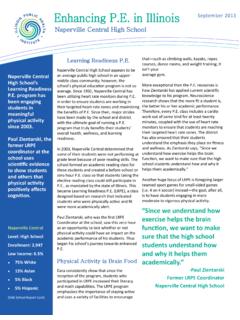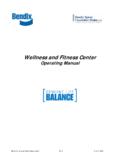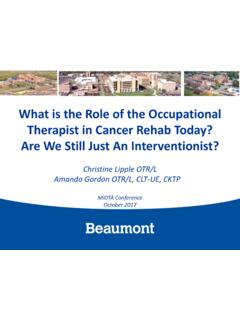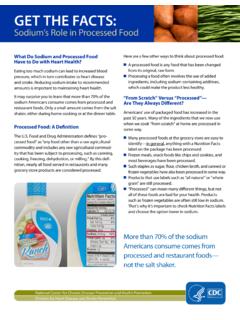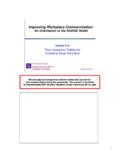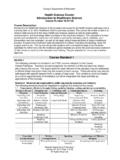Transcription of IAPO Worksite Wellness Resource Guide
1 IAPO Worksite Wellness Resource Guide Dear Friend, Many of us do not stop to consider how much our environment affects our health, or the role it plays in driving the obesity epidemic. However, the reality is that health begins in the places where we live, work, and play places like our homes, our neighborhoods, and our workplaces. Many people attribute obesity and chronic disease to lifestyle choices, but substantial research provides solid evidence suggesting that where we live affects how we live. It is much more difficult for people to adopt healthy lifestyles if healthy options are not available. The good news is that this means we can foster good health by improving the places around us, by making sure that we have access to healthy and affordable food options, places for our families to run and play, and work environments that promote employee wellbeing.
2 Employers have the opportunity to be champions in addressing the obesity epidemic. On average, em- ployees spend almost half of their waking hours Considering all the time employees spend at the workplace, employers have a great opportunity to make a substantial impact on their employees'. health. Simply put, workplaces matter for building healthy communities. In the same way that healthy workplaces matter for employees, healthy employees matter for business. Currently, the government picks up a large portion of the costs associated with obesity-related chronic disease, but employers shoulder a significant amount of the burden as well. Almost a quarter of health care spending by employers and employees is associated with ten modifiable risk factors, and obesity contributes the largest proportion of the excess Reduced productivity and absenteeism due to ill- ness are also a huge cost to employers.
3 If employers are truly concerned about excessive spending, they must take bold action starting with their own workplaces. Investments in Worksite Wellness can help busi- nesses improve their bottom line by reducing health care spending and creating more productive workers. Likewise, healthcare organizations have a real opportunity to model healthy environments and practices. Hospitals are in the business of keeping people healthy, not just treating them when they are sick. Mak- ing their workplaces healthy goes to the heart of their mission and the consequences of inaction bear out in their institutions. The healthcare sector can lead by example. Workplace Wellness programs are a central strategy to prevent many of the common risk factors for car- diovascular disease and stroke including tobacco use, physical inactivity, obesity, hypertension, high cho- lesterol, and diabetes.
4 Employers are finding that investing in employee health is not only the right thing to do, but that it also pays back. In 2011, the American Heart Association published a review of more than 200 studies and concluded that for every $1 spent in Wellness programs, companies could save an aver- age of $ 1 Table 1. Time Spent in Primary Activities (1) and Percent of the Civilian Population Engaging in Each Activity, Averages Per Day by Sex, 2011 Annual Averages. Economic News Release. Washington, DC: Department of Labor, Bureau of Labor Statistics, 2011. 2 Goetzel, R. Z., Pei, X., Tabrizi, M. J., Henke, R. M., Kowlessar, N., Nelson, C. F., & Metz, R. D. (2012). Ten modifiable health risk factors are linked to more than one-fifth of employer-employee health care spending. Health affairs, 31(11), 2474-2484.
5 IAPO Worksite Wellness Resource Guide 2. (continued from previous page). in medical costs and $ in absenteeism costs. Companies reap benefits not only from cost savings, but also from improved employee productivity and satisfaction. Employee health is a worthwhile investment. Everyone benefits from Worksite Wellness programs: employ- ers, employees, shareholders, and the broader community. When we are healthier as a society, we all bene- fit. We have a stronger workforce, a better economy, and higher quality of life. Worksite Wellness programs boost employee morale and health, and are good for business, to boot. Elissa Bassler CEO. Illinois Public Health Institute Heather Gavras Senior Director, Community Health American Heart Association LaMar Hasbrouck, MD, MPH. Director Illinois Department of Public Health IAPO Worksite Wellness Resource Guide 3.
6 Introduction The importance of addressing the environment that surrounds individual decision-making and promotes healthful behaviors is recognized as an important obesity prevention Individuals are viewed within the larger context of community, family and Over 130 million Americans are employed across the United States and a significant part of their day is spent at work. Additionally, time spent at work has increased over the last two decades, making the workplace environment a significant target for obesity prevention efforts in particular. The Illinois Alliance to Prevent Obesity supports the implementation of a comprehensive and evidence-based set of workplace Wellness initiatives that incorporates an assessment of readiness to change, as well as modifications of the Worksite environment that facilitate healthy behaviors.
7 In particular, strategies focused on the implementation of policy, environmental and system level changes will lead to increased sustainability. This Resource Guide includes policy and implementation information in areas such as physical activity, alternative scheduling, healthy vending, and breastfeeding support. Additionally, it contains information about assessing current Worksite Wellness and forming a committee. IAPO Worksite Wellness Resource Guide 4. I. Why care about Worksite Wellness ? Employee Health Promotion Programs: What is the Return on the Investment? This issue brief demonstrates the impact of Wellness programs on employee health and productivity and provides evidence that employers implementing such programs gain a substantial return on investment. Key findings: Unhealthy lifestyle behaviors contribute to at least 25% of health care expenditures in the workplace The average return on investment (ROI) for workplace health promotion programs is $ for every $1 spent invested.
8 ROI estimates for individual companies in analysis ranged from $ to $13. Citibank's Wellness program achieved an ROI between $ and $ per $1 invested. Sustainable, well-designed Wellness programs with high employee buy-in are most likely to yield high returns on investment. Additional factors influencing outcomes include: longevity of the program, participation levels, size of company, employee demographics, and environmental factors. Health Policy Brief: Workplace Wellness Programs This brief describes how the Affordable Care Act will expand the ability of employers to reward workers who achieve health improvement goals, and reviews the current evidence base for employer benefits associated with Worksite Wellness programs. Key findings: Average employer costs dropped about $ for every $1 when health and Wellness programs were present.
9 Additionally, costs for days that employees were absent fell $ Minnesota Toolkit (P. 3). This fact sheet discusses how employers benefit financially from Wellness programs. Key Findings: Poor employee health leads to about a 51% decrease in productivity Loss of productivity due to health issues can cost employers about $ billion annually. One review of health promotion programs demonstrated an estimated 30% reduction in sick leave, health costs, and worker's compensation. Worksite Wellness Programs for Cardiovascular Disease Prevention : A Policy Statement From the American Heart Association An article from the American Heart Association that connects workplace Wellness policies to cardiovascular health. National Healthy Worksite Training Manual (CDCiii, P. 1-5). A comprehensive Guide to Worksite Wellness from the CDC that outlines the benefits of creating a healthy Worksite .
10 IAPO Worksite Wellness Resource Guide 5. II. Starting a Wellness Committee Saving Dollars and Making Sense: Committee Guide A comprehensive Guide to creating a Wellness committee at your Worksite . Contains meeting plan and step-by-step implementation information. Kaiser Permanente Toolkit Set the stage for building a culture of health in your company. Key Findings: Gain leadership endorsement- Having buy-in from key leaders facilitates policy change. Build a multi-level program- Your program should work on many levels (cultural, environmental, company, individual). Target the most important health issues Communicate to motivate- Generate excitement for your program by sending periodic reinforcements or updates. Reward and incentivize employee participation and success. Building a Healthier Chicago: Building a Healtheir Workplace Guide (Pgs.)

